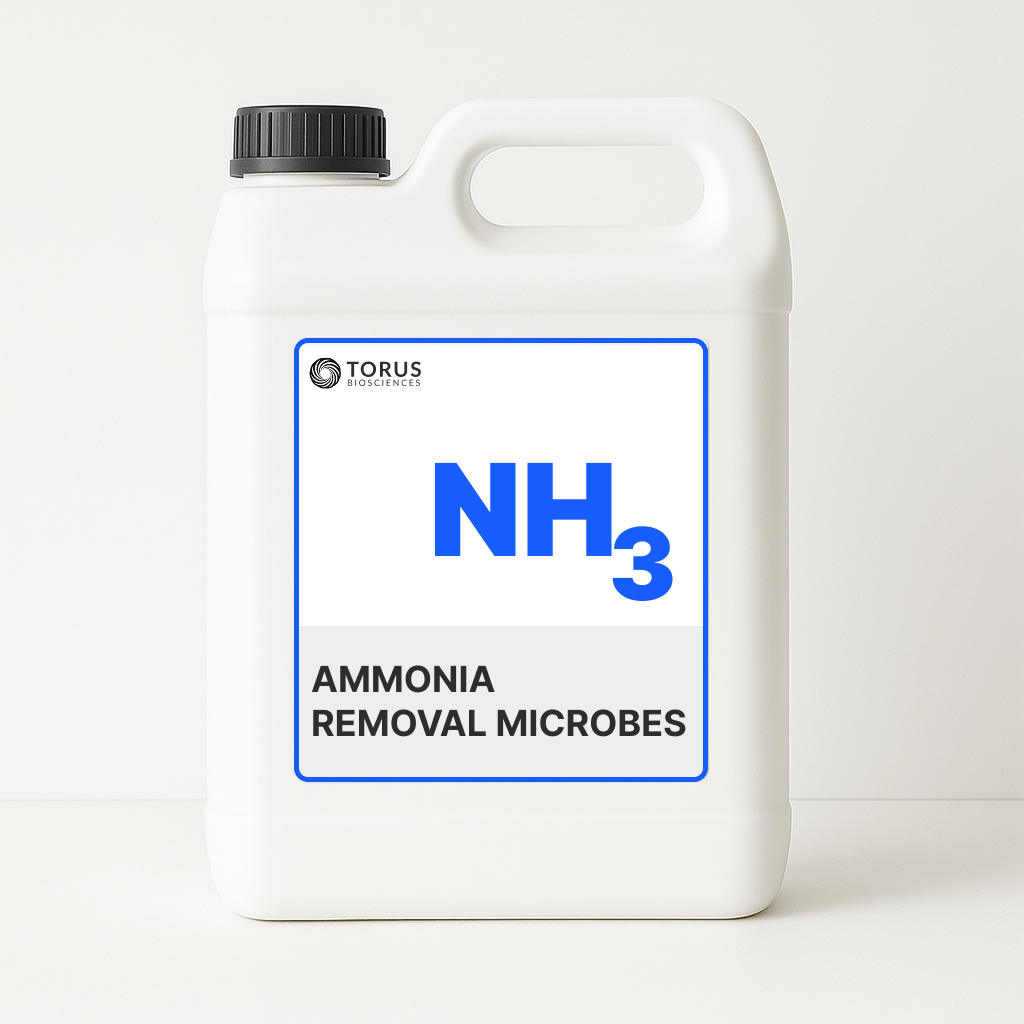
Ammonia Removal Microbes
Specialized microbial consortium designed for efficient removal of ammonia from wastewater and aquaculture systems.

Torus Ammonia Removal is a powerful consortium of nitrifying and heterotrophic bacteria specifically formulated to transform toxic ammonia into harmless nitrogen compounds. This specialized microbial blend addresses one of the most challenging pollutants in wastewater and aquatic systems through biological pathways that convert ammonia first to nitrite and then to nitrate or nitrogen gas, effectively eliminating ammonia toxicity while avoiding chemical treatment drawbacks.
Field applications demonstrate that this microbial formulation can reduce ammonia concentrations by 80-99% in various applications including industrial and municipal wastewater, aquaculture systems, and agricultural effluents, providing a sustainable and cost-effective solution to ammonia pollution challenges across multiple sectors.
Benefits
-
Superior Ammonia Removal: The microbial consortium achieves 80-99% ammonia reduction across various applications, effectively addressing this toxic pollutant even in challenging environments with fluctuating conditions. The multi-stage biological process ensures that ammonia is completely transformed rather than just temporarily bound or sequestered.
-
Non-Toxic Treatment Approach: Unlike chemical ammonia removal methods that often introduce other potentially harmful substances, this biological solution converts ammonia into harmless compounds through natural metabolic processes. The end products (nitrate or nitrogen gas) are environmentally benign at typical concentrations.
-
Protection of Aquatic Life: By rapidly eliminating ammonia, which is highly toxic to fish and other aquatic organisms even at low concentrations (as little as 0.05 mg/L can harm sensitive species), the formulation creates safer aquatic environments in both natural water bodies and controlled systems like aquaculture operations.
-
Biofilm Establishment: The consortium actively develops stable nitrifying biofilms on available surfaces, creating a self-sustaining treatment system that continues to process ammonia long after initial application. These biofilms provide resilience against system fluctuations and temporary adverse conditions.
-
Adaptability to Various Conditions: The diverse microbial community functions effectively across a range of temperatures (10-35°C), pH levels (6.5-8.5), and salinity conditions (freshwater to brackish environments), allowing application in diverse settings without requiring precise environmental control.
-
Reduced Operating Costs: Compared to chemical ammonia removal approaches, the biological treatment significantly reduces ongoing operational expenses. After initial establishment, the self-replicating microbial community requires only periodic reinforcement rather than continuous chemical dosing.
-
Simultaneous Organic Matter Reduction: In addition to ammonia removal, the heterotrophic components of the consortium reduce organic pollutants (BOD/COD), providing dual treatment benefits in organically-loaded systems. This combined action improves overall water quality beyond just ammonia control.
Applications
Aquaculture Systems:
-
Recirculating Aquaculture Systems (RAS): The consortium rapidly establishes nitrifying biofilms in biofilters, effectively controlling ammonia in high-density fish production. Systems using these microbes have maintained ammonia levels below 0.1 mg/L even at fish stocking densities up to 100 kg/m³, significantly exceeding conventional biofilter performance.
-
Pond Aquaculture: In shrimp and fish ponds, the formulation prevents ammonia spikes common during feeding cycles and biomass increases. Regular application maintains water quality even in intensively managed ponds, reducing water exchange requirements by 40-60% while supporting higher stocking densities.
-
Ornamental Aquaria: The microbial blend rapidly cycles new aquarium systems and recovers damaged biological filtration after medication or disruption. Hobbyists report 60-80% faster tank cycling times compared to conventional methods, minimizing fish stress during critical setup periods.
-
Live Transport Systems: For transporting live aquatic organisms, the formulation maintains water quality during extended shipments, reducing ammonia-related mortality by 50-70% compared to untreated transport water, particularly valuable for high-value species and long-duration transports.
Industrial Wastewater Treatment:
-
Food Processing Effluents: The consortium effectively treats high-ammonia wastewaters from meat, dairy, and seafood processing facilities. Treatment systems have demonstrated 85-95% ammonia removal from these challenging effluents with high organic loads and protein content.
-
Tannery and Textile Wastewater: In these industries, where ammonia-based compounds are used extensively, the formulation provides targeted ammonia reduction while tolerating the other chemicals present. The adaptable microbial community adjusts to the specific chemical profile of each facility’s effluent.
-
Pharmaceutical Manufacturing: The microbial solution addresses ammonia in pharmaceutical wastewaters without disrupting other biological treatment processes or introducing substances that might react with pharmaceutical compounds, maintaining treatment efficacy even with variable waste streams.
-
Landfill Leachate: The consortium targets the characteristically high ammonia concentrations in landfill leachate (often 500-2000 mg/L), achieving substantial reduction when incorporated into leachate treatment systems through both nitrification and subsequent denitrification processes.
Municipal and Other Applications:
-
Municipal Wastewater Treatment: The formulation enhances ammonia removal in conventional activated sludge systems, particularly valuable for facilities struggling to meet increasingly stringent ammonia discharge limits. Bioaugmentation with the consortium has helped numerous facilities achieve compliance without costly capital upgrades.
-
Sludge Digestate Treatment: Anaerobic digestion of sewage sludge produces effluent with high ammonia content; the consortium effectively treats this digestate, enabling water reuse or safe discharge while capturing valuable nutrients.
-
Agricultural Runoff Treatment: The microbial solution helps remediate high-ammonia runoff from livestock operations and fertilized fields, protecting receiving water bodies from eutrophication and ammonia toxicity while preserving nitrogen in forms beneficial for plant growth in constructed wetlands or bioreactors.
-
Disaster Response: The formulation provides rapid ammonia control in compromised water systems following natural disasters or infrastructure failures, helping restore water quality when conventional treatment systems are damaged or overwhelmed.
For optimal results, Ammonia Removal Microbes should be introduced when ammonia levels are beginning to rise but before they reach toxic concentrations. The consortium performs best in well-aerated environments with adequate surface area for biofilm formation, though selected strains will continue functioning even under suboptimal conditions.
This biological approach to ammonia control represents a sustainable, environmentally sound solution that harnesses natural microbial processes to address one of the most challenging water quality issues across multiple industries and applications, providing long-term ammonia management with minimal environmental impact.
Key Microorganisms
Ammonia-Oxidizing Bacteria (AOB): The consortium contains specialized nitrifying bacteria that perform the crucial first step in nitrification, converting ammonia (NH₃) to nitrite (NO₂⁻). These chemolithoautotrophic bacteria derive energy from ammonia oxidation and carbon from dissolved CO₂, allowing them to function in environments with minimal organic carbon. The proprietary AOB strains in the formulation can process 2-5 mg of ammonia nitrogen per gram of cells per hour under optimal conditions.
Nitrite-Oxidizing Bacteria (NOB): Complementary nitrite-oxidizing microorganisms complete the nitrification process by oxidizing the nitrite produced by AOB to nitrate (NO₃⁻). These bacteria prevent the accumulation of nitrite, which can be toxic at high concentrations. The specialized NOB strains in the consortium operate efficiently even at low nitrite concentrations, making them valuable for polishing applications where nitrite levels are minimal.
Heterotrophic Denitrifiers: The formulation includes facultative anaerobic bacteria that can convert nitrate to nitrogen gas (N₂) under anoxic conditions. These microorganisms complete the nitrogen removal process in systems where full nitrogen elimination (rather than just ammonia conversion) is desired. The consortium’s denitrifiers are selected for their ability to function in environments with fluctuating oxygen levels.
Supporting Microorganisms: Complementary bacterial strains enhance the performance and resilience of the primary nitrifiers. These include heterotrophic bacteria that consume organic matter that might otherwise inhibit nitrification, phosphate-accumulating organisms that remove phosphorus while supporting nitrifier growth, and biofilm-forming species that create protective microenvironments for the sensitive nitrifying bacteria.
Mechanism of Action
-
Nitrification Pathway: The core ammonia removal process follows the two-step nitrification pathway:
- Step 1: NH₄⁺ + 1.5O₂ → NO₂⁻ + 2H⁺ + H₂O (performed by AOB)
- Step 2: NO₂⁻ + 0.5O₂ → NO₃⁻ (performed by NOB)
- This complete pathway converts toxic ammonia to nitrate, which is significantly less harmful to aquatic life.
-
Denitrification (Optional): Under anoxic conditions, denitrifying bacteria in the consortium complete nitrogen removal:
- NO₃⁻ → NO₂⁻ → NO → N₂O → N₂ (nitrogen gas)
- This step converts nitrate to nitrogen gas that escapes harmlessly to the atmosphere, achieving complete nitrogen removal rather than just ammonia transformation.
-
Biofilm Development: The consortium bacteria adhere to surfaces using extracellular polymeric substances, forming structured nitrifying biofilms with:
- Outer layers dominated by heterotrophs that protect nitrifiers from inhibitory substances
- Middle layers rich in ammonia oxidizers (AOB)
- Inner layers containing nitrite oxidizers (NOB)
- This layered structure optimizes electron donor/acceptor transport and maximizes nitrification efficiency.
-
Quorum Sensing Communication: Bacteria in the consortium use quorum sensing molecules to coordinate activities, resulting in more efficient colonization and ammonia processing through synchronized gene expression and metabolic activity across the microbial community.
-
Enzymatic Systems: The ammonia-oxidizing bacteria employ the ammonia monooxygenase enzyme complex to catalyze the initial oxidation of ammonia, while nitrite oxidizers utilize nitrite oxidoreductase. These specialized enzyme systems allow for energy generation from these otherwise challenging nitrogen transformations.
-
Stress Response Mechanisms: The formulation includes strains with enhanced resistance to common stressors in wastewater and aquaculture systems:
- Oxygen fluctuation tolerance through cytochrome variations
- Temperature resilience via stress proteins and membrane adaptations
- Resistance to organic loading through competitive heterotrophic metabolism
- These adaptations ensure performance even under suboptimal conditions.
Available Variants




Boost productivity with our sustainable biological solutions.
Trusted by agricultural and waste management professionals for superior results.
Request pricing & availability